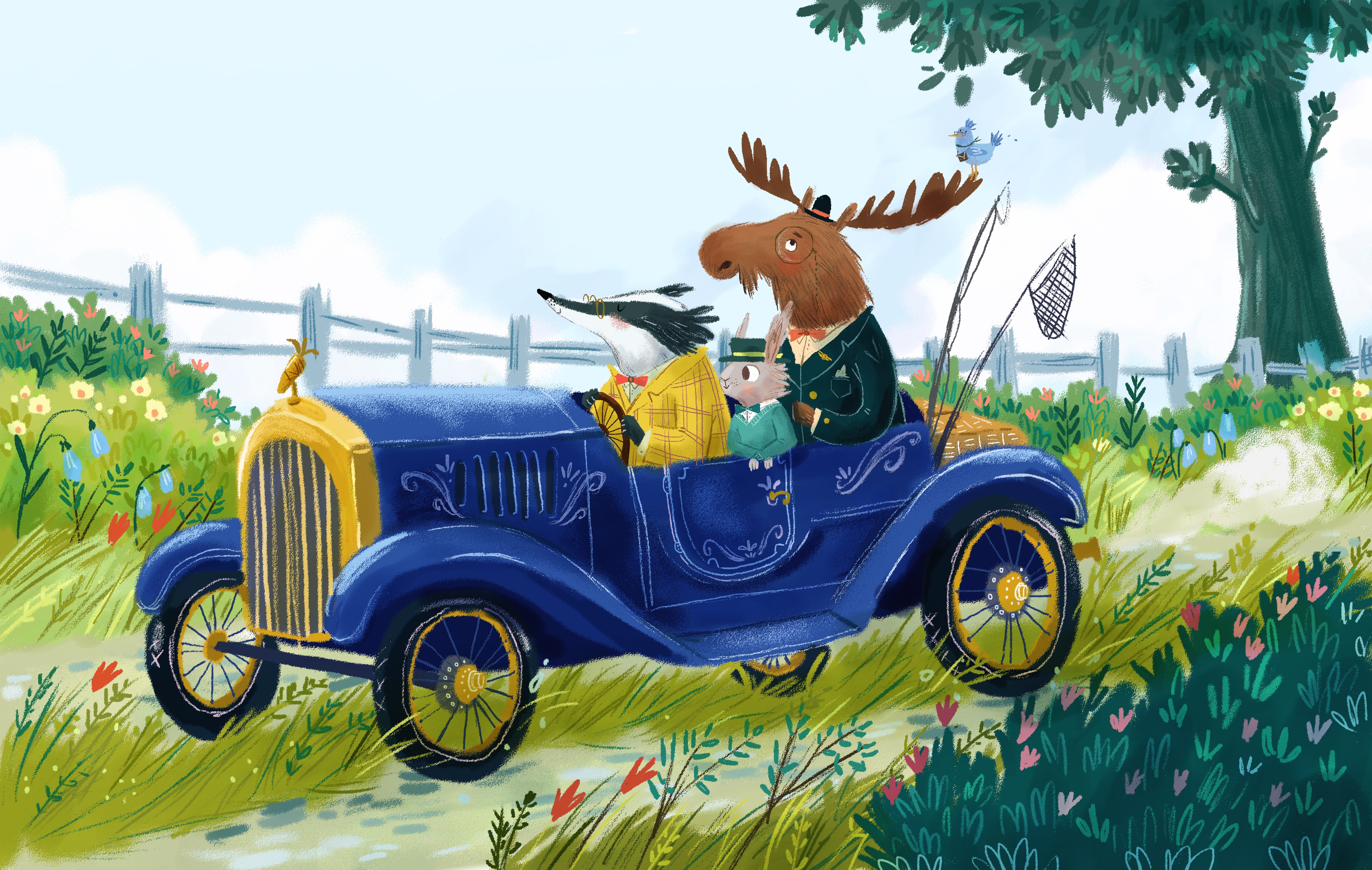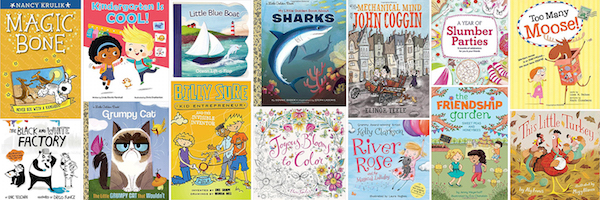Do I Need an Agent? A Chat with Bright Managing Agent James Burns
last updated 10 February 2017

Illustration by Graham Ross
It was an honor and a privilege to be asked by Giuseppe Castellano, Executive Art Director at Penguin Random House, to help answer the question “Do I Need An Agent?” on his blog at the end of last year. Along with five other talented kid lit agents, I spoke to the merits of having an agency and helped explain what we, as agents, do. I’m excited to share the full text of my interview below:
Question: What do you look for in a submission?
When looking for the first time at an artist’s portfolio, I like to see a cross section of their work. The main reasoning behind this stems from the fact that what an artist feels is their strongest work is not necessarily what the agent would agree is best for the market. Regardless, I like to seek out three main strengths anytime I review a portfolio: storytelling ability, consistency and confidence.
The first is storytelling ability which has admittedly become more blurred over the years, but the key principles still stand strong. There must be character interaction between the characters featuring in the story, whilst the illustration must convey an emotional connection with the reader—can they identify with the character’s emotions such as sadness, happiness, jealously or love? Finally, the piece must be aesthetically pleasing. We all know that illustration is hugely subjective to the viewer, but the checklist in my head is as follows: palette, key line, texture, use of negative space, and lastly, small details within the piece as a whole.

A fantastic example of storytelling ability from Bright artist Rosie Butcher.
In terms of consistency, I ask myself, “can the artist portray a style in numerous pieces of artwork?” Through consistency comes confidence and ownership of style. I’ve had firsthand experience of an artist creating a sample for a project and being given the commission, only to find maintaining that standard of work too challenging for the 16 spreads the commission called for.
Illustrators, take note here—in creating a sample for a project you are setting a benchmark for the rest of the title. Make sure that this is an achievable benchmark for you in terms of consistency along with working to the schedule and the project budget.
Secondly to considering those three qualities, I gauge how well the dreams, ambition and vision are aligned with that of the agent’s. In my experience of engaging with illustration majors at colleges and universities in both UK and US, everyone’s dream project is the jacketed hard cover picture book. This, I believe, stems from the kudos that the ‘kid lit’ and picture book industry and community gives to this type of project. However, it is worth remembering that it represents only a tiny segment of children’s publishing industry. There is a whole other world of commissioning opportunities outside of this small segment—board and novelty books, middle grade books, chapter books, Young Adult books, nonfiction books…and this doesn’t even take into account art licensing, editorial or advertising commissions.

A wide variety of titles that James has worked on.
Question: What is one misconception about agents?
An age old misconception originates from a simple question—how can we give equal quality, time and support to more than one artist?
It is my belief that it comes from the onboarding process. As mentioned above, when an artist joins Bright, and here I can only speak about Bright, an artist’s dreams and ambition must be aligned with those of the agency. This enables us to put a plan in place before the first portfolio sheet is made. An agent will intuit which clients are going to respond well to the artist’s work, and this becomes the first port of call for an illustration agent when initially pitching, sharing and presenting the portfolio to commissioning clients. The agent then dedicates energy and resources to get that first commission. Once that commission has been accepted, the ball is then in motion.
One of the many benefits of Bright is that we have agents spread across two continents, with global reach. Each agent has a specialty area that spans multiple industries. One of the positives of this method is that agents can maximize an illustrator’s time without flooding the artist’s work in one sector.

The Bright team (plus artists and family members) all in one place for the 2016 artist picnic.
Additionally, artists need to be given the time to create wonderful strong, consistent illustration. Once a project has been commissioned, there is a slight window of pause before having to consider the plan that we put in place to enable the illustrator to take steps forward in their publishing career. Bright is invested and continues to invest in a bespoke piece of software, Sparklebox, which looks after all artist assets, scheduling management, contracts and publication schedules. This gives a tremendous amount of transparency when looking at an artist’s career and enables the agents to maximize time and resources in providing top level support to a diverse portfolio of artists.

James meeting an old friend at the 2016 Toy Fair (which inspired Bright artist Zoe Persico!)
Question: Why do I (acting as an author/illustrator) need an agent?
The answer to this is clear to me: because it plays to strengths. The cycle of creating successful titles is like putting on a play—everyone must work to the best of their abilities. Artists are creators, agents have insight and continued relationships,editors and art directors have the vision.
Any agent worth their weight is in a position of privilege given that we see a birds eye view of the industry, have a fantastic understanding of the publishing houses (in particular what the editors and art directors are looking for) and a deep understanding of imprint lists — which may not be obvious from looking online or at backlist titles. When an agent is pitching or submitting the work, it is my belief that the success rate is so much higher. It is a precise and qualified process, rather than spread betting your work across people who you do not know apart from an impression of them through social media.
Only with collaboration of people playing their part and bringing their strengths to the table can a successful title take form. If I look at the most successful titles in the industry and try and identify the root of that success, it always comes down to the team behind it. As an agent, we must look past illustration and be confident in our ability to matchmake personalities as well as skillsets—most importantly between the publisher and the artist. Just as importantly, we must have a total overview of the illustrators’ work as it enables us to schedule projects and assignments in harmony to best position the illustrator at any given time. Thus we can also follow the development plan that was plotted when they first reached out to us.
It’s also lovely to have a seasoned expert in the form of a contract manager to give clarity and explanation to legal mumbo-jumbo.

Global Contracts Manager, Sandra Tharumalingam, joined the Bright team in 2016! Read more HERE about Sandra’s role at Bright.
Other benefits being that the agent has a little more weight behind them for when there are unforgiving terms to negotiate in parts of the contract that we do not like, as an agent-artist team. We have the professional support and knowledge to care for our artists’ best interests.
Lastly, the benefit is being represented by an agent that has got their finger on the pulse and understands the rhythm of publishing. We’re able to spot trends before they enter the marketplace and this knowledge becomes invaluable in ensuring that your portfolio is as current and fresh as possible. The overwhelming advantage in having this knowledge is proven when we come to share new work; it cuts through the noise and competition.
Get to know James!
James initially studied Fine Art at Central St Martins in London. Starting out as a PA at Bright 6 years ago, James now specializes as an agent in commercial illustration based in the US Bright office. This internal progression has been invaluable, giving him a detailed understanding of every part of the business, to achieve steady growth alongside the company. With proven success in his management skills with external and internal stakeholders, James provides fuss-free creative solutions across all genres of children’s literature. He has built a reputation in publishing by understanding the needs of his commercial and fictional audience – not to mention his warm and approachable personality.

Twitter: @brightburns
Email:james.burns@thebrightagency.com